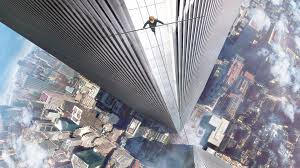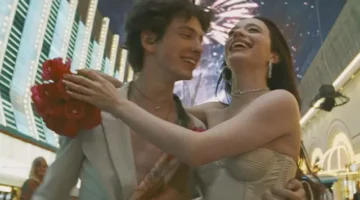Tropic Sprockets / The Walk
By Ian Brockway
Joseph Gordon-Levitt gives an immersive preformance in Robert Zemeckis’ film “The Walk,” detailing a formative quest of the famed wire walker, Philippe Petit. The film is richly told, helped in no small measure by the breathless and wonderful 3D showing a living New York City.
Petit’s beginnings are theatrical indeed. As a youngster in Paris, he was a street performer doing a kind a mime where he drew a circle around himself and remained silent within the orb. He would not tolerate any one to enter his realm, often stepping upon others.
One day with his wire act, he meets the vivacious Annie (Charlotte Le Bon.) Romance blooms.
During a performance, Petit cracks a tooth. After he is treated brusquely by a man in the waiting room, he sees the World Trade Center, then under construction, in a magazine. His tooth pain vanishes.
Like a muralist in seeing a masterwork upon a white wall, Petit sees a single line between two high points wherever he goes. In the Trade Center, the artist discovered his muse. He yearns to walk on a wire between the two buildings over one thousand feet from the city below.
The film does an excellent job portraying Philippe Petit as a more than subversive artist of the body, using balance, equilibrium and the power of the unexpected as his tools. There is also more than a sprig of Surrealism in his soul.
The film’s first highlights are its Chaplinesque tones, showing the daredevil as a bohemian trickster, bumping and rolling, startling children and catching others off guard. The city of Paris in 1972 mirrors this carnival sense as well: motley people loiter in the street, folk singers strum Leonard Cohen on guitars and the police are hated.
Ben Kingsley appears as Papa Rudy, a master acrobat who advises him in his dream that Petit calls a “coup”. No one except his girlfriend Annie thinks he can do such a thing.
The marvel of “The Walk” is that it expresses Petit’s act as it was intended: a walk upon a wire that was interpreted as both entertainment and an act of civil disobedience. It can also be seen as a yearning to be one with Nature, a very literal journey to become a part of inner and outer space. In a few scenes, Joseph Gordon-Levitt is shown as a black asterisk against the sky, scoring a revolution of human Will. The virtuosic perspective, dizzying and very nearly shocking, puts you within one heartbeat of Petit on his tread.
But that is not all. The last piece de resistance is a shot of the Trade Center as a shining compass that is singed at the edges as if burnt by the sun. Poignantly, Petit says in a voiceover that his pass to the observation deck of the building is meant to last forever.
[livemarket market_name="KONK Life LiveMarket" limit=3 category=“” show_signup=0 show_more=0]










No Comment